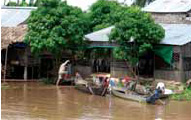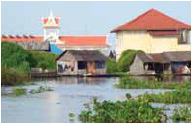

Flood Management and Mitigation Programme
The Flood Management and Mitigation Programme (FMMP) aims to prevent, minimise or mitigate people’s suffering and economic losses due to floods, while preserving the environmental benefit s of floods. The MRC Regional Flood Management and Mitigation Centre (RFMMC) in Phnom Penh provides technical and coordination services to the four Member States including forecasts, flood data, and training packages. Achievements over 2007 are listed below according to the five programme components:
Component 1: Establishment of the RFMMC
Construction of the new RFMMC building was completed with the
financial support of the Government of Japan, and the programme
has already moved in. An inauguration ceremony will be held
in April 2008. Communications between the MRCS and RFMMC, including
video conference facilities, have been installed. Routine daily
short term flood forecasting and river monitoring has continued,
with significant improvement in the dissemination time.

A ‘roadmap’ has been developed to improve institutional and management systems and RFMMC flood forecasting capabilities. Separate institutional and technical reports have been produced. It was recommended that the RFMMC improves the current short- and medium-term flood forecast. The programme is moving towards this through developments in three main areas: data collection, the operational database, and models:
- Three MoUs confirming cooperation between national line agencies and the MRCS on rainfall and water level data transfer for medium-term flood forecasting were sent to three countries for review and approval; two are already signed. For Thailand, the Terms of Reference for this purpose are under preparation. Based on the approved Framework Agreement, the FMMP and national line agencies will make separate detailed work plans and contracts. These can be updated as necessary to provide continuous close cooperation in data acquisition and transfer.
- The HYMOS hydrological database, with selected adjustments, has been adopted as a combined operational and historical database for the RFMMC. HYMOS hardware and software have been installed followed by an advanced training course.
- Using URBS and CatchmentSIM software, the process of building and calibrating 50 sub-catchments within the Mekong River Basin is almost complete. Model performance and data transfer from the member countries to the RFMMC are now being tested.
A report on the 2006 hydrological situations in the LMB was prepared for the Twenty-Fifth Meeting of the MRC Joint Committee in May 2007. The number of on-ground rainfall observation stations used for this report was increased from 25 stations to 60. A more in-depth analysis of rainfall data was also introduced.

The 5th Annual Mekong Flood Forum was held in Ho Chi Minh City in May 2007 under the theme “Improving Data Inputs towards Medium-term Flood Forecasting and Warning in the LMB”. Nearly 150 participants agreed on the importance of data in improving medium-term flood forecasting and warning in the basin. The forum also stressed the importance of information sharing to minimise flood damage.
Phase 1 of the USAID/OFDA funded project to provide early flood warning to vulnerable communities in Cambodia and the Lao PDR has entered its final stage. Evaluations have been positive, and based on recommendations from the 4th Annual Mekong Flood Forum in 2006, an assessment and inventory of flood vulnerable communities across the whole LMB is now being undertaken. These are critical to the design of both physical and institutional interventions and have led to the formulation of an 18-month project on flood and drought vulnerability indices.
A pilot project entitled “Strengthening Flood Management Capacity for the Kok River in Chiang Rai Province” was started in Thailand. This will provide flood risk maps for part of Chiang Rai province plus a set of guidelines and recommendations for flood mapping and forecasting.
The second phase of the Asia Flood Network on Radio, Internet and Satellite Rainfall Estimation project is ongoing. In addition, USAID has offered to provide funding to support the implementation of a regional Flash Flood Guidance System and for development of the Geospatial Stream Flow Model.
Component 2: Structural measures and
flood proofing
The tendering process for recruitment of an international consulting
firm to implement the “structural measures and flood proofing”
project, which started in October 2006, was completed in June
2007. The consulting firm commenced its contract in September
and will provide service for 22 months, including an inception
phase.
FMMP staff have developed a framework for the development of guidelines for the BDP. The Best Practice Integrated Flood Risk Management Guidelines for the BDP document will enable the MRCS and line agencies to identify and assess the likely impacts on flood risk and behaviour of development scenarios and projects being considered for inclusion in the BDP. Meanwhile the Roads and Floods project, aimed at providing guidelines on best practices for the design of the roads in floodplain areas of Cambodia and Viet Nam, has been on-going since mid 2006. To date, the pre-flood, flood and post-flood surveys have been conducted while all data and reports have been submitted to project partners for further analysis. The project will be completed in March 2008 following publication of the guidelines.


Component 3: Enhancing cooperation in
addressing trans-boundary flood issues
Based on the recommendations of the October 2006 regional consultation
on the implementation of FMMP Component 3, the component document
has been modified and retitled. Two other important documents,
a working paper on the MRC mandate in addressing and resolving
differences and disputes, and a report on identification of
flood trans-boundary issues have also been prepared.
Component 4: Flood emergency management
strengthening
After successful completion of the phase II project, the European
Commission Humanitarian Aid Office approved the phase III project
“Support to Implementation of Flood Preparedness Programmes
at Provincial, District and Commune Levels in the Lower Mekong
Basin”. The 15-month project started in January 2007. In Cambodia,
various field trips and a teacher orientation school programme
were carried out. In the Lao PDR, a workshop on finalising the
flood preparedness manual and a training course for key staff
at Disaster Management Committees in Khammouane Province and
Nong Bok district were conducted. In Viet Nam, “School Flood
Safety Programme” orientation sessions for school teachers were
conducted in the three target districts of Tien Giang province.
Component 5: Land Management
Activities in 2007 included:
- Finalising the approach for generating flood probability information for the Mekong flood plains;
- Developing a computer application to turn numerical flood probability statistics into graphical outputs;
- Combining this application with GIS software to arrive at a user-friendly interface for the interpretation and presentation of flood probability information;
- Production of a manual explaining how to use the application and the interface, plus translation into the four riparian languages;
- Training of trainer courses on using the flood probability information;
- Support to training courses for line agency staff members in the four riparian countries on using the Component's products in land-use planning.
An MRC-GTZ joint progress review mission for the phase I project, “Flood Emergency Management Strengthening and Land Management” under FMMP components 4 & 5 was carried out in June-July 2007. The mission positively evaluated the first phase and recommended continuation into a second phase with a total budget of €2 million from January 2008-December 2009. The main objectives of phase II are to help the Member Countries apply better disaster risk reduction, plus appropriate land management policies and tools related to floods. Management of the German contribution to these components will be strengthened by lessons learned from phase I. A no-cost bridging phase ran until the end of December 2007.
The FMMP is funded by the Governments of Denmark, France, Germany, Japan, the Netherlands and the United States; as well as the Asian Development Bank and the European Union.
Choose a newsletter: